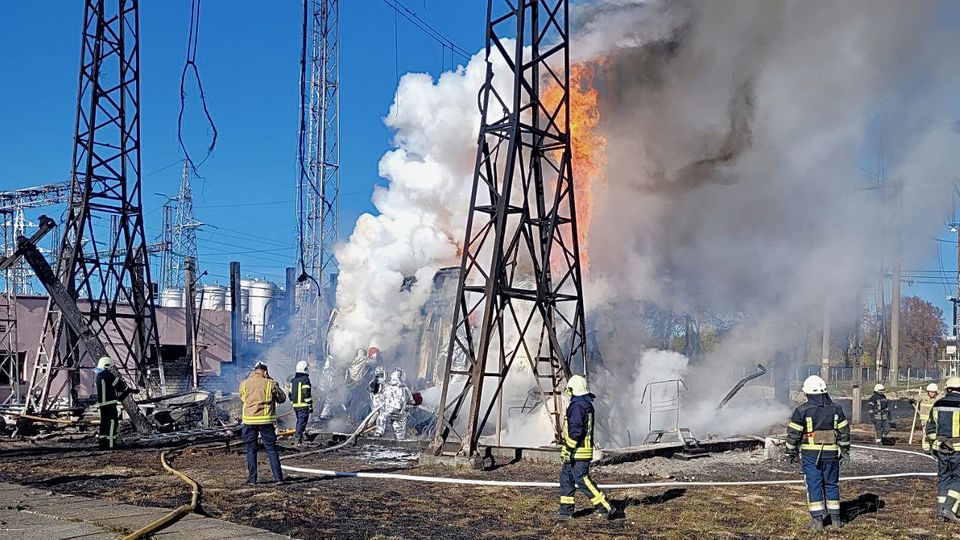Setback for Russia
How Ukraine is slowly changing the rules of the game in the Black Sea
A Ukrainian soldier stands on a boat in the Black Sea with an anti-aircraft missile.
© Anatolii Stepanov / AFP
The Ukrainian army keeps a corridor open in the Black Sea for grain exports and repeatedly attacks Russia’s Black Sea Fleet. The Ukrainian tactics in the Black Sea are increasingly working – and the country hardly has any warships.
A Ukrainian patrol boat leaves the port of the Black Sea city of Odessa, a regular target of the Russian army. A member of the Ukrainian Coast Guard stands at the bow with a Stinger missile launcher on his shoulder, watching the sky. The patrol boat is part of the strategy Kiev to keep the Russian military fleet away from the Ukrainian coast.
On Tuesday, the Ukrainian army reported a new success in the region: a warship from the Russian Black Sea Fleet was shot at and destroyed. Kremlin spokesman Dmitry Peskov spoke of “damage” suffered by the landing ship “Novocherkassk” as a result of a Ukrainian attack in the port of Feodosiya on the Crimean Peninsula annexed by Russia.
Ukraine keeps corridors free for grain exports
Despite the supposed superiority of the Russian fleet and despite Russian threats of attack, the Ukrainians have managed to open and maintain a shipping corridor for grain exports in the southern part of the Black Sea. “This is remarkable because Ukraine has virtually no warships,” two US experts recently said on the DefenseNews website.
For Ukraine, it is the only major military success this year, in which the front line remained almost unchanged despite a Ukrainian counteroffensive. According to Ukrainian naval spokesman Dmytro Pletenchuk, Russia is now “on the defensive” in the Black Sea, in contrast to the “arrogant presence off the coast” at the start of Russia’s war of aggression in February 2022. At that time, Moscow had de facto access to Kiev Sea denied.
The Black Sea is essential for Ukrainian grain exports and at the same time extremely strategically important for Russia. The Ukrainian peninsula of Crimea, located in the north of the inland sea and annexed by Moscow in 2014, is crucial for Moscow both for supplying its troops in Ukraine and for its attacks on the neighboring country.
Kiev intensifies attacks on Crimean ports
Since Moscow withdrew from an international agreement on grain exports in August, it has become even more important for Ukraine to control the Black Sea. Kiev has also increased its attacks on Russian military facilities in Crimea. A spectacular Ukrainian attack on the Russian fleet’s headquarters in Sevastopol in September forced Moscow to move its ships further east.
“Our anti-ship missile systems have fundamentally changed the rules of the game,” says Pletentschuk. These are US-made “Harpoon” missiles and the “Neptune” missiles produced in Ukraine, both with a range of around 300 kilometers.
Pletenchuk said Ukraine has also created a new, top-secret brigade specializing in the use of maritime and underwater drones for mine clearance, reconnaissance and attacks on Russian targets. The Ukrainians have destroyed twelve Russian ships and damaged 22 more since the beginning of the invasion, the navy spokesman emphasizes.
War in Ukraine
Cold, power outages, storms: the second winter of war is plaguing the Ukrainians at the front
The Ukrainian secret service says it has developed “unique” naval drones that can transport an 800-kilogram explosive charge up to 800 kilometers away, even in moderate storms. These drones, dubbed “Sea Baby,” were primarily used in the attack on the bridge between Crimea and Russia in July, as well as in successful attacks on ten Russian ships since October 2022.
The Ukrainian Coast Guard and the Naval Forces of Ukraine control around 200 kilometers of coastline and the ports of Pivdenny, Odessa and Chornomorsk, as well as Ismail and Reni on the Danube further south. And despite Russian threats against civilian shipping in the region and “systematic attacks on port infrastructure,” Ukraine has been able to export ten million tons of grain through the shipping corridor since August, according to Infrastructure Minister Oleksandr Kubrakow.
On the Ukrainian Coast Guard patrol boat, the crew uses binoculars to spot a cargo ship that has entered Ukrainian territorial waters after passing the Bulgarian and Romanian coasts. Border guards in riot gear are preparing to board the ship to search for weapons, ammunition and explosives, according to Oleksandr Yakovenko, assistant to the coast guard commander in Odessa.
After completing the inspection, the men leave the freighter using a small rope ladder that is attached directly to the hull and sways in the waves. According to Yakovenko, the unit has inspected more than 2,200 ships since the beginning of the year. A fit, well-trained team could manage around 15 ships per day – despite the constant threat of Russian attacks.



